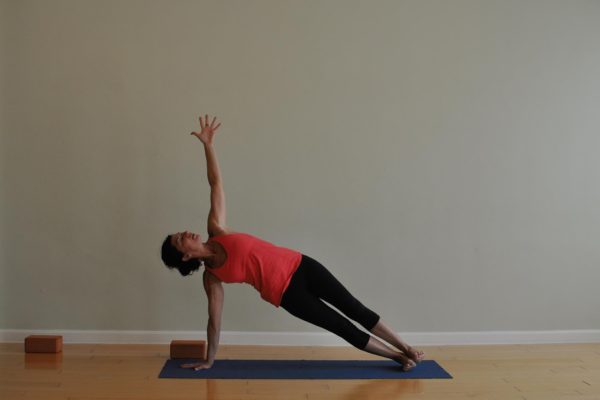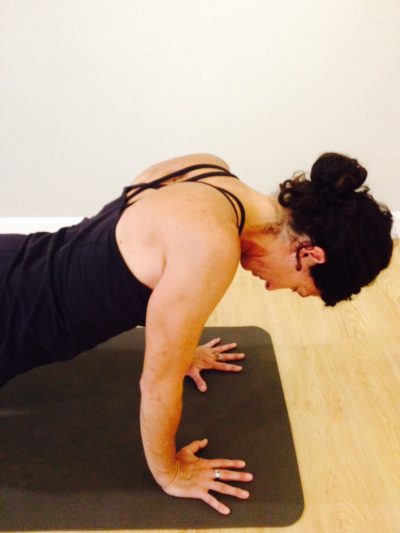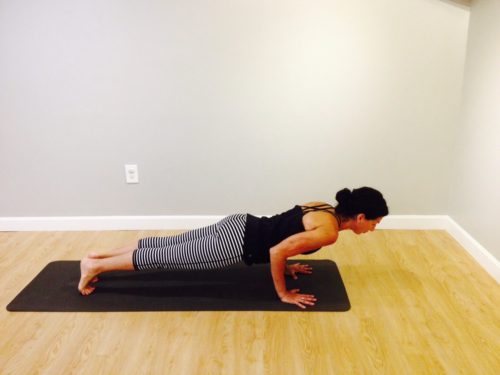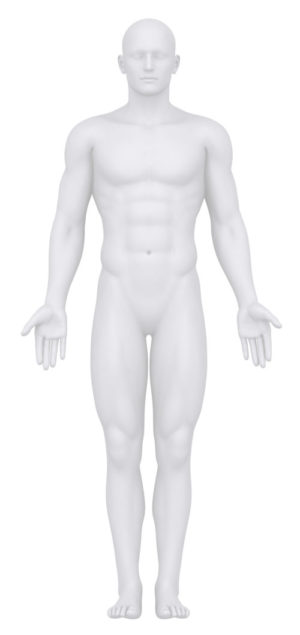
I had a light bulb moment with one of my students this weekend. By “light bulb” I mean she had one of those revelations about her practice that makes the lights go off in my head signifying that I’m doing exactly what I love in exactly the way I was meant to do it.
By “it,” of course I’m talking about teaching yoga. The light bulb for me was found in her reaction to the way I presented cues about moving from high to low push up and the position of the head (more on that later). Her reaction was one of elation, one of “I got it!” and one of “this is really gonna stick in my brain and body going forward.” THAT’s exactly what I hope to do through my teaching.
So with metaphorical light bulbs going off all around us (lol), let’s dive into the content of what we were discussing. I’ve talked about this before in other posts but it’s always a good review. The subject at hand is moving from High to Low Push Up and specifically, in this case, the position of the head.
What I noticed in that class, as I do in many classes, was that many students were using only their upper body to move through that pose. Their core and legs were basically left out of contributing to the movement and as many of them moved into Low Push Up, their heads dropped towards the floor. Think of it more as a “slump” versus a low push up position:

You can see in the picture here, my core is dropping towards the floor as is my head. There’s no integrity in this shape and my neck, over time, will feel the brunt of it.
So, when observing this position in a lot of the students, I stopped the flow and asked them all to come into High Push Up/Plank. I asked them to keep their heads steady as they lowered and to press into the floor. We did it a few times, moving from High to Low and then Up to Down Dog. What I then observed is many students were able to maintain a steady head position without all the drooping:

If you want to make it really easy for people to understand, you can share what I shared with this student:
Think about your head position in Tadasana or anatomical position. In this pose/position, the head is centered over the body:

As I explained to her, if you consider and note that the head is centered here over the body, maintain this position as you move through the practice so the weight of the head does not pull you into a slumping position and further, so that the muscles of the neck aren’t overtaxed or overused. We’re looking for balance and when the head droops, even in poses like Triangle and Side Angle, it can wear unevenly on the muscles on the side of the neck like the sternocleidomastoid and scalenes and when we drop the chin excessively (as in looking down at our mobile devices) we can overstretch the neck extensors like the splenius capitus and cervicis.
Once I made the connection for her to Tadasana, that was her real “light bulb moment.” In my experience, it doesn’t always require complex explanations or even an extensive understanding of anatomy, the names of the involved muscles and the biomechanics involved. Sometimes it’s more about providing general principles in a clear way and connecting them to actions both on and off the mat. Because as we know, the extensive use of phones and other mobile devices has us all hunching a great deal during the day so making this connection for students can help them make these changes in their daily posture too.
I have a short mini-course online on the subject of moving from High to Low Push Up. It will give you all the helpful cues and more on the involved anatomy. You can get it for just $20 here.
For a quick video on the subject, visit my You Tube channel by clicking here.Â
If you like to learn anatomy as you practice, you can download my full practice videos on Vimeo. Each practice is only $10. You can find the classes here and here.
One final thing: If you’d like a template to help you build yoga sequences with ease, download my free template on “How to Build  A Yoga Sequence.” This quick and easy worksheet will lay out the factors to consider and give you a format you can use each time you want to build a new sequence for your students:
Thanks for reading and feel free to comment!
